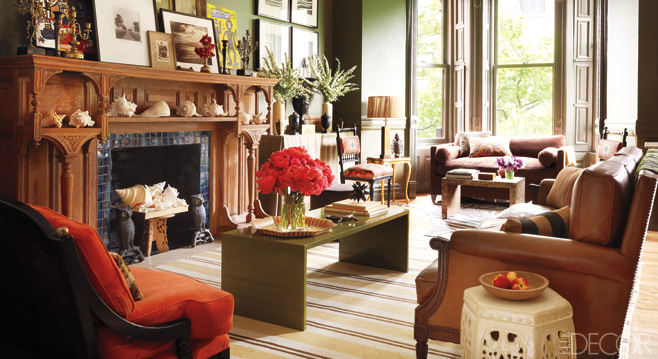A Harlem Brownstone’s Vivid Transformation

In the summer of 2008, Elaine Griffin’s mother, a Georgia belle with perhaps a tad too much time on her hands, began a campaign to push her daughter, a New York–based interior designer, to finally find a mate. Griffin admittedly hadn’t made marriage a priority. The Yale graduate spent her twenties in Paris doing publicity for Céline and Givenchy; in her thirties she was an assistant designer to Peter Marino, the king of haute retail architecture. She opened her own design studio in 1999 and published a book, Design Rules: The Insider’s Guide to Becoming Your Own Decorator, in 2009. “I had a commitment problem,” she concedes, “and I was crazy about my work. Plus, I used my kitchen entirely for shoe storage.”
Griffin began a 30-day online “dating spree,” which she figured would supply enough horror stories to quench her mother’s fire. On day 21, however, she got an e-mail from Michael McGarry, a psychoanalyst who had also never married. “He wasn’t just interesting,” she recalls. “He was compelling, which isn’t an adjective I use often.”
The couple were engaged three months later and married on New Year’s Eve of 2009. Their home in an 1890s Harlem brownstone is a testament to the challenges—and triumphs—of two people meeting in midlife and learning to share space stylishly. The 1,000-square-foot apartment is filled with saturated colors and unexpected juxtapositions of shape and texture. If there is one rule Griffin goes by, it’s that provenance is bunk. “My one passion is for pretty,” she says. “I love amazing things, but I think it’s pretentious to decorate a home based on names.”
For Griffin, renovating and decorating her first “married” apartment—the space had not been touched since the 1970s—was a fairy tale, at least at the outset. McGarry was moving from a 400-square-foot bachelor pad with virtually no furniture—“the perfect husband for a decorator,” she jokes. Griffin felt she could do whatever she wanted. Her meticulous plans included a blithe takeover of the spacious second bedroom as her office and an enormous walk-in closet for that prodigious shoe collection. But when she showed the plans to her husband, he immediately shot back: “Where do I go?”
“I really had to rethink things,” Griffin says. “It was a mortifying moment.” She returned to her sketches and figured out a way to carve a new clothes closet out of a corner of the bedroom, then donated most of her beloved footwear to a resale shop. Meanwhile, the existing walk-in closet became McGarry’s study, a cabinet of curiosities with a vintage globe, a butterfly collection, and a Persian Botemir rug. “It was the smartest concession I ever made,” she says. “It’s a place for him to relax and to feel his life is totally his own.”
Griffin painted the living room—with its classic bay window and original oak mantel surrounded by smoky-blue tiles—in a dark, rich green that sets off what she calls a “random” collection of photographs, etchings, and prints, including a Gustave Le Gray seascape. The decorator’s shell collection, a nod to her childhood on the Georgia shore, is another focal point: “I love the subtle colors against the earthy walls,” Griffin says. A custom-made sofa upholstered in chocolate-brown velvet nestles in the nook of the bay window with a zebra-skin rug (“I’m sorry, but you have to go with the real thing,” she states firmly). A Louis XVI–style sofa was found at the Paris flea markets, while two Regency-style chairs covered in Ralph Lauren Home orange corduroy are thrift-shop discoveries. Above one of the chairs hangs a Hunt Slonem watercolor. A hand-painted Asian trunk serves as a side table.
For Griffin, shopping in the puces of Paris, every decorator’s go-to source, will always have a personal association; she and McGarry found themselves there in the midst of their apartment re-do in 2009, when the market’s dealers were suffering mightily from the economic downturn. “It was unlucky for them, but fortunate for us,” she says. One of her dearest finds is a set of Louis XV–style chairs. Upholstered in caramel-color velours de soie, they surround the dining table, below an original artwork Griffin created by making 15 photocopies of a self-portrait by Sandro Botticelli and giving them Warhol-style makeovers.
Perhaps the master bedroom best expresses how an adult couple can find their own language of design without compromising their individuality. The room has an Asian influence that reflects McGarry’s extensive travels—a vintage tapestry in red and gold hangs above a custom-made headboard, and an antique wedding sari covers the bed. Meanwhile, Griffin’s beloved Paris is represented by a pair of lithographs the couple found in a gallery on rue des Saints-Pères. A funky vintage chest of drawers holds its own against the room’s dark-blue walls.
“After so many years of making all my own decisions, thinking that I knew what was best,” says Griffin, “it was hard to remember there was someone else there, with his own ideas. But making that work really made things deeper for me.”
Click here to see the beautiful Harlem brownstone.
Written by Nancy Hass • Styled by Peter Frank • Photographed by Joshua Mchugh